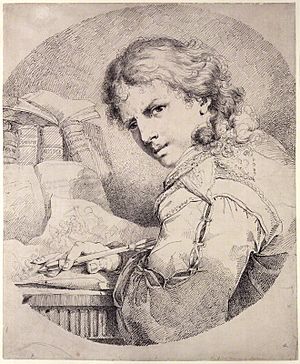James Jefferys facts for kids
Quick facts for kids
James Jefferys
|
|
|---|---|

self-portrait
|
|
| Born | 19 May 1751 |
| Died | 31 January 1784 |
| Nationality | British |
James Jefferys (born May 19, 1751 – died January 31, 1784) was a talented British artist. He was known for his engravings and paintings. Years after his death, in the 1970s, many of his lost drawings were found. This discovery helped people understand his art better.
Contents
The Early Life of James Jefferys
James Jefferys was born in Maidstone in 1751. His father, William Jefferys, was also an artist. He worked as a coach painter. James learned a lot about art from his father.
James also trained with William Woollett, a famous engraver. Woollett was also from Maidstone. Later, James joined the Royal Academy to study art.
Artistic Talent and Awards
James Jefferys quickly showed his artistic skill. In 1773, he won a gold medal at the Royal Academy. This was for his drawing called Seleucus and Stratonice. That same year, he began showing his art at the Society of Artists. The next year, he won another prize from the Society.
Studying Art in Rome
Sir Joshua Reynolds, a very important artist, recommended James. Because of this, the Dilettante Society paid for James to study in Rome. He was supposed to stay for three years, but he stayed for four!
In Rome, James created many classical drawings. These drawings often showed exciting or dramatic scenes. However, it's not known if he created any paintings there. Some people said James had a "wild time" in Rome. They also thought his behavior was a bit unusual.
Life as a Professional Artist
When James returned to England, he opened his own art studio. It was located in Soho, London. He continued to create art and exhibit his work.
His Most Famous Work
James Jefferys' most important painting was The Scene before Gibraltar on the morning of 14 Sept. 1782. He showed this painting at the Royal Academy in 1783. The painting showed a key moment during the Great Siege of Gibraltar. During this siege, the Spanish used special floating ships. These ships were designed to be unsinkable.
William Woollett, James's former teacher, started to make an engraving of this painting. An engraving is a print made from a drawing. Sadly, Woollett died before he could finish it. Another artist, John Emes, had to complete the engraving.
James Jefferys died in Soho, London, in January 1784. He passed away from a cold. He was only 32 years old.
James Jefferys' Legacy
James Jefferys' Gibraltar painting was shown again in 1804. It was displayed at the European Museum. For many years, some of James's drawings were thought to be by other artists. People often believed they were by James Barry or John Hamilton Mortimer.
Rediscovery of His Art
In the 1970s, a collection of James Jefferys' drawings was found in Maidstone. This discovery helped experts realize which drawings were truly his. They were then correctly identified.
Today, you can see James Jefferys' art in important places. His work is in the National Portrait Gallery and the Victoria and Albert Museum. His famous Gibraltar painting is at the Maidstone Museum & Art Gallery. His art is considered important, even though it was influenced by other artists.


